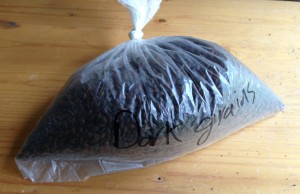Black malt is a misunderstood grain. Written off by many early homebrew authors as yielding burnt, sometimes ashy flavors, and an acrid aroma, it’s actually a fairly mildly-flavored malt, given its extreme color. Because a large amount of the aromatic compounds developed during kilning are vented from the kiln, black malt has a subdued aroma compared to other darkly-roasted grains — something a simple sniff test will show you. Because our sense of taste is highly influenced by our sense of smell, the relative lack of aroma to black malt means that it tastes milder than one might expect. Once you understand the actual properties of black malt, you will have an edge over homebrewers who refuse to use it, or don’t understand what it really adds to a beer. [Read more…]
The Truth About Black Malt
 Homebrew malt myths die hard. This is especially true for myths that may have a grain of truth to them. (Get it, a grain of truth?) Likewise, myths that seem to be confirmed by casual observation can be hard to debunk. Case in point — black malt (sometimes called black patent malt). This very dark malt has been described as lending an aggressively burnt taste to beers that contain it. Sometimes the adjectives “sharp” and “acrid” are used, and less commonly you will even see it described as ashy. Sources that describe black malt in that manner frequently urge brewers to minimize its use, or to use debittered (or dehisked) black malt in its place. Debittered black malt is black malt that has had the husks removed. As the name implies, it adds less roast “bitterness” to beers brewed with it.
Homebrew malt myths die hard. This is especially true for myths that may have a grain of truth to them. (Get it, a grain of truth?) Likewise, myths that seem to be confirmed by casual observation can be hard to debunk. Case in point — black malt (sometimes called black patent malt). This very dark malt has been described as lending an aggressively burnt taste to beers that contain it. Sometimes the adjectives “sharp” and “acrid” are used, and less commonly you will even see it described as ashy. Sources that describe black malt in that manner frequently urge brewers to minimize its use, or to use debittered (or dehisked) black malt in its place. Debittered black malt is black malt that has had the husks removed. As the name implies, it adds less roast “bitterness” to beers brewed with it.
This description of black malt is a mishmash of truths and falsehoods, and perhaps for this reason many homebrewers still cling to this poor description. Let’s start with what’s wrong and then describe the malt as it really is.
Black IPA
If you want to brew a beer that tastes like an American-style IPA, but with a darker color, I have two words for you — black malt. Black malt, sometimes called black patent malt, is the darkest of the roasted malts, usually measuring around 500 °L. Given the details of how the maltster vents the kiln during roasting, almost all of the volatile aromatic compounds from this malt are lost. (Take a handful of black malt in one hand and a handful of roasted barley — unmalted bakley roasted to the same color — and smell the difference.) If you want to add color to a beer, but little aroma or flavor, black malt is the way to go.
There are also dehusked black malts available. These dark malts are the same color as black malt, but yield less roasted bitterness. This makes them the ideal choice for a black IPA. Dehusked black malts go by a variety of names. Briess calls theirs Blackprinz malt, Dingemans calls their debittered black malt. Weyermann calls theirs dehusked Carafa III. [Read more…]




Recent Comments